Movies Are Never What They Seem |
This article first appeared in |
| Written by: Keith Swadkins, (retired) is the president of The International Cinerama Society. He has a back ground as a projectionist and cinematographer. | Issue 50 - September 1997 |
|
Have you ever wondered where your favorite
movie was actually shot? For a variety of reasons, it is often not possible
to shoot a movie where it is actually set. Obtrusive modern developments and
the logistics of movie making often demand sequences be shot thousands of
miles from the places they are set. As a teenage projectionist, I stared in
wonderment at the exotic locations on the screen and, later in life, as a
cameraman, I was able to identify and visit many of these places. To fly
over an Hawaiian mountain ridge and see Bali Hai appear ahead has to be one
of life's most memorable moments, but more of "South Pacific"
(1958) later. Here are just a few of the Cinerama/70mm film locations known
to me. Cinerama has been the formative influence on my life and was the start of my love affair with the cinema. When Lowell Thomas said "This is Cinerama!", my life changed as the magical triple image carried me to places in the world that I could only dream of visiting. Whilst the locations of the Cinerama travelogue are obvious, the prologue to "This Is Cinerama" (1952) features an excerpt from the pioneering western "The Great Train Robbery" (1903), shot not in the wild west, but in Paterson, New Jersey, on the long defunct Lackawanna and Western railroad. 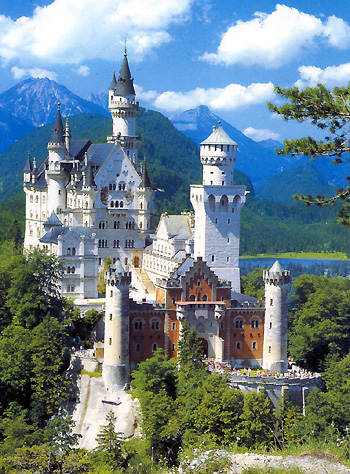 Postcard Postcard"The Wonderful World of the Brothers Grimm" (1962) tells the story of the two brothers who collected and published folk stories from all over Europe. The film was shot entirely in 3-strip Cinerama using various German locations. The Grimm's home town of Kassel had been largely destroyed during the War and for the movie was replaced by picturesque Rothenburg ob der Tauber whilst nearby Weikersheim Castle became the home of the despotic Grand Duke. During their research into the ancestry of the Grand Duke, Wilhelm and Jacob Grimm travel to Rhineburg, portrayed by Oberspaya, sailing on a vintage Rhine paddle steamer which in reality arrived at a special built dock in Bad-Ems. Rhineburg Cathedral was portrayed by Regensburg Cathedral whilst in the episode The Dancing Princess, Russ Tamblyn danced all over Neuschwanstein Castle, a location also used for exteriors in "Chitty Chitty Bang Bang" (1968). Filming of "How The West Was Won" (1962) started May 26, 1961 at Paducah, Kentucky, and continued for nearly a year. The story follows the Prescot family as they fight their way west. We first meet them on the banks of the Ohio River where these sequences were filmed. The subsequent tragedy, when their rafts are carried over the rapids, was filmed using stunt performers, 1600 miles away on the Rogue and McKenzie Rivers, Oregon. The setting for The Covered Wagon sequences was Montrose, Colorado whilst the Buffalo Stampede was filmed on a specially constructed set in Custer State Park, South Dakota. The Sierra Railroad, a preserved line near Sonora, Northern California is a favorite Hollywood location. "Bad Day at Black Rock" (1955) and "High Noon" (1952) are just two movies that have used this location, which was the setting for the Railroad Bandits sequence. As the story finishes, the surviving members of the Prescot family ride into the sunset in Monument Valley, Utah, courtesy of authentic long shots and process photography. Monument Valley has been used in countless movies and is one of the remotest and most imposing locations in regular movie use. The finale of "How The West Was Won" brings the story up to present day, showing the modern west. As our journey across the continent ends, we fly over the Glendale Interchange, Los Angeles in what were to be the last Cinerama shots ever taken, filmed by Robert Surtees on the last day of filming, May 16, 1962. There are often conflicting claims regarding where a movie was shot. "South Pacific" (1958) is one of these cases. In fact it was shot on Kauai, the most westerly of the Hawaiian islands. A few years ago I had the opportunity to spend some time there and to experience the magic of this tropical island, which has been the location for many Hollywood movies. Elvis was "married" on the canal of the Coco Palms Hotel at the end of "Blue Hawaii" (1961) whilst Indiana Jones escaped his pursuers during the opening sequence of "Raiders of the Lost Ark" (1981) by diving into the nearby Wailua River. A glimpse of the river can also be seen behind the main titles of "South Pacific" whilst a nearby, private estate provided the settings for "Jurassic Park" (1992). In 1989, whilst filming from a helicopter flying along the inaccessible Northern shores of Kauai, the pilot inserted a tape cassette into the intercom and, to the famous theme, we banked over a ridge and straight ahead was the Bali Hai of the 1958 movie. In the movie, Bali Hai is portrayed as a distant mystical island by means of matte shots, but the actual location is on the island of Kauai itself, being filmed, with considerable set additions, on the beach of Na Pali whilst the nurses and SeaBees were based on the adjacent Lumahai Beach. |
Further in 70mm reading: |
|
"South Pacific" is based on a collection of short stories,
Tales of the South Pacific, by James Michener. The story of the French
planters transporting their daughters to neighboring Bali Hai, away from the
GI´s, is based on an actual event. A recent biography identified the real
Bali Hai as Moorea, 12 miles of Tahiti in the Society Islands. If Bali Hai
is your idea of a South Sea paradise, then Moorea must come very close to
that ideal. It was whilst driving along the only road on the island that we
passed a waterfall beneath which a local girl was sitting, washing her hair.
This was for real....not in a movie. However, the remote island of Tahiti is
probably best known for its association with Captain William Bligh and the "Mutiny
on the Bounty". Bligh dropped anchor in Matavia Bay, Tahiti on
October 26, 1788 and started a Hollywood legend. He remained until April 4,
1789 collecting breadfruit before setting sail for the West Indies. During
this period, the crew had savoured ALL the delights of this idyllic place
and 24 days later mutinied and eventually returned to Tahiti. |
|
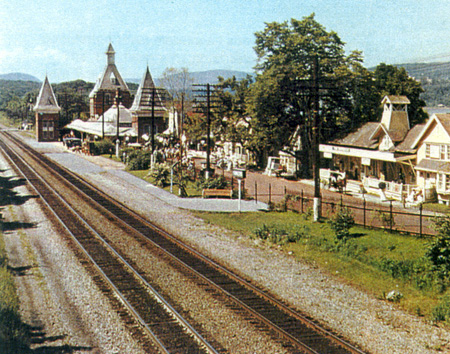 From
"Hello, Dolly!" "Yonkers" set. From American Cinematographer. From
"Hello, Dolly!" "Yonkers" set. From American Cinematographer.For the 1962 movie, with Marlon Brando and Trevor Howard, MGM built a replica of the Bounty but oversized to accommodate the Ultra Panavision 70 cameras. The arrival at Tahiti was staged where it originally happened at Matawaii bay. Today Matawaii bay is little changed, a quiet beach on a majestic bay, a few miles North of the capital Pepeete. Other sequences were shot on Moorea at Temae and Cook´s Bay, where, until recently, one of the canoes built for the movie was still displayed outside a restaurant. In the 1984 version "The Bounty", Mel Gibson played the mutinous Fletcher Christian with Anthony Hopkins as Bligh. This time a truescale Bounty was built and again filming was in the Society Islands. Bligh´s arrival was filmed at Pao Pao, Moorea, the Tahitian village, in reality, being part of a hotel complex. Much of the location work seems to have been in the Cook´s Bay area. As for the two ships, the MGM one was moored several years ago in Miami as a tourist attraction whilst Mel Gibson´s Bounty sails daily on lunch and dinner cruises in Sydney Harbor. |
|
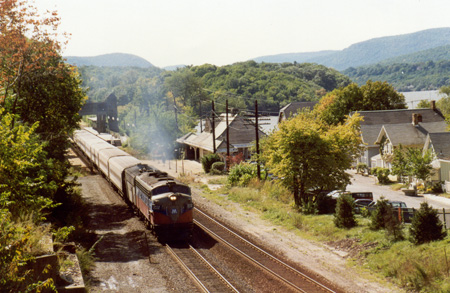 Same
view 1988 of Garrison´s Landing. Image by Keith Swadkins Same
view 1988 of Garrison´s Landing. Image by Keith SwadkinsAcross now to the East Coast of the USA and "Hello, Dolly!" (1969). Changes over the last 90 years ruled out Yonkers, where the first part of the movie is set, so Gene Kelly took the cast and crew 50 miles up the Hudson to the tiny village of Garrison´s Landing, opposite West Point Military Academy. To this day, reminders of the film still exist. The local real estate office still has the Vandergelder Hay and Feed signs on the windows, it's exterior was Walter Matthau´s store. Along the road, the false frontage of a barber's shop has been left in place as well as the gazebo on the riverside lawns. However, this is a replacement, the original having rotted some years ago. The station, scene of the major production number "Put on your Sunday Clothes", was embellished with a barn (to hide the car park) and several additional buildings were temporarily added to the platforms. Otherwise, little has changed since 1969 when the Todd-AO cameras were here. |
|
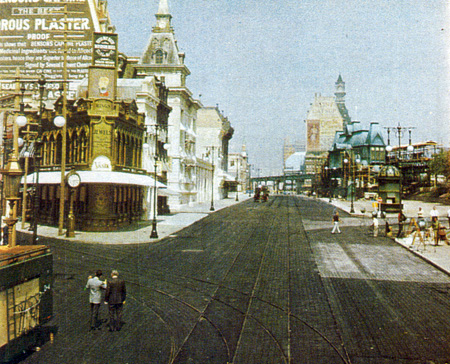 From
"Hello, Dolly!"'s New York set. From American Cinematographer. From
"Hello, Dolly!"'s New York set. From American Cinematographer.The New York scenes were filmed on a specially built street set which lined the main avenue of the Twentieth Century Fox studios on West Pico Boulevard. Much of the set was still in situ in 1988. Hollywood came into being because of the dependable sunshine and the variety of scenery available in California. Just north of Hollywood is Malibu Creek State Park, originally the Twentieth Century Fox Studio ranch. Countless movies have filmed here, including TV´s MASH which for many years had a permanent set in a remote area of the park, nearly 3 miles from the car park. However, only a couple of burnt-out Jeeps remained by 1988 to mark the location of the MASH hospital. You can hardly turn a corner in Los Angeles without suffering deja-vu. The first time I ever drove into LA I took a wrong turning and found myself at the intersection of Ocean Drive and the Pacific Coast Highway, Santa Monica where, in "It's A Mad, Mad, Mad, Mad World" (1962), the taxis pursuing the fleeing Spencer Tracy make a U-turn, Jonathan Winters apparently falling out of the car and completing the turn hanging out of the open door. Much of the final chase was shot in Santa Monica. |
|
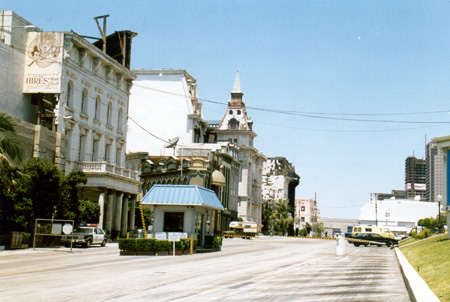 Same
view of "Hello, Dolly!"'s New York set in 1992. Image by Keith Swadkins Same
view of "Hello, Dolly!"'s New York set in 1992. Image by Keith SwadkinsWhen it comes to filming epics, the need for large unspoiled areas that can convincingly double for the historic locations can take the film unit a long way from the authentic sites. For "The Greatest Story Ever Told" (1965), the Holy Land was replaced by Nevada whilst "Ben Hur" (1959) was shot almost entirely within 50 miles of Cinecitta Studios, Rome. The famous chariot race took place in an old quarry behind the studio and, before mattes were added, traffic could be seen in the background, speeding along the Rome Ring Road. A similar problem occurs in "Spartacus" (1960), where, I am assured, The Hollywood Freeway can be discerned in the background of ancient Rome, shot on the lot at Universal. "Spartacus" used mainly Utah and California locations, the most identifiable being Death Valley (opening sequence) and Hearst´s Castle at San Simeone (Olivier´s Villa). The main battle scenes utilized the Spanish Army and were filmed outside Madrid. "King of Kings" (1961) transformed Spain into the Holy Land. The Sermon on the Mount was filmed in the Chinchon Hills, Nazareth was a set built at Mazanares and the River Jordan a stream near Aldea del Fresno. Navacerrada became Golgotha and Lake Alberche became the Sea of Galilee. "El Cid" (1961) was at least set in Spain with the battle of Valencia being shot on the beach at Pensiccola, though the city walls and the fortress were a set. In the 70mm prints, a blue bus could be seen in the background driving along the costal road during the battle. The tournament at Calahora was filmed at Belmonte Castle in La Mancha Province. It has been said the camera cannot lie. As a cameraman I would correct that statement...the camera always lies. Nothing is what it seems on the screen! A classic example of this occurs in "On the Waterfront" (1954) when Marlon Brando and Eva Marie Saint are apparently sitting on a park bench with the Hudson River in front of them and a church behind. Sorry to disillusion you but the shots from behind the bench, looking towards the river, were filmed in Stevens´s Park, Hoboken (N.J.), whilst the frontal shots were taken 4 blocks inland using the Church of Our Lady of Grace, as the background. Now, that's the movies for you! |
|
|
Go: back
- top - back issues Updated 22-01-25 |
